Trends in Educational Research about e-Learning: A Systematic Literature Review (2009–2018)
Abstract
1. Introduction
1.1. Definition of e-Learning
1.2. Previous SLRs about e-Learning Research
- 1.
- To identify the research topics about e-learning and education that were published in international high-impact scientific journals in the period of 2009–2018.
- 2.
- To reveal the educational theories about e-learning that were used in international high-impact scientific journals in the period of 2009–2018.
- 3.
- To determine the most used e-learning modality in studies published in international high-impact scientific journals in the period of 2009–2018.
- 4.
- To identify the methodologies of educational research used in studies published in international high-impact scientific journals in the period of 2009–2018.
2. Materials and Methods
3. Results
3.1. Research Themes and Subthemes about e-Learning and Education (2009–2018)
3.2. Educational Theories about e-Learning
3.3. Most Studied e-Learning Modality
3.4. Research Methodologies in the Analysed Articles
4. Conclusions
O1. To identify the research topics about e-learning and education that were published in international high-impact scientific journals in the period of 2009–2018.
O2. To reveal the educational theories about e-learning that were used in international high-impact scientific journals in the period of 2009–2018.
O3. To determine the most used e-learning modality in studies published in international high-impact scientific journals in the period of 2009–2018.
O4. To identify the methodologies of educational research used in studies published in international high-impact scientific journals in the period of 2009–2018.
Author Contributions
Funding
Acknowledgments
Conflicts of Interest
Appendix A
References
- The World Bank World Bank Education and COVID-19. Available online: https://www.worldbank.org/en/data/interactive/2020/03/24/world-bank-education-and-covid-19 (accessed on 15 June 2020).
- UNESCO COVID-19 Educational Disruption and Response. Available online: https://en.unesco.org/covid19/educationresponse (accessed on 8 May 2020).
- World Bank Individuals Using the Internet (% of population) | Data. Available online: https://data.worldbank.org/indicator/IT.NET.USER.ZS?name_desc=false (accessed on 8 May 2020).
- Bates, T. Crashing into online learning: A report from five continents—And some conclusions | Tony Bates. Available online: https://www.tonybates.ca/2020/04/26/crashing-into-online-learning-a-report-from-five-continents-and-some-conclusions/ (accessed on 8 May 2020).
- Vázquez-Cano, E.; León Urrutia, M.; Parra-González, M.E.; López Meneses, E. Analysis of Interpersonal Competences in the Use of ICT in the Spanish University Context. Sustainability 2020, 12, 476. [Google Scholar] [CrossRef]
- Statista E-learning and digital education. Available online: https://www.statista.com/topics/3115/e-learning-and-digital-education/ (accessed on 8 May 2020).
- World Commission on Environment and Development. Our Common Future; Oxford paperbacks; Oxford University Press: Oxford, UK, 1987; ISBN 978-0-19-282080-8. [Google Scholar]
- Stepanyan, K.; Littlejohn, A.; Margaryan, A. Sustainable e-Learning: Toward a Coherent Body of Knowledge. J. Educ. Technol. Soc. 2013, 16, 91–102. [Google Scholar]
- Stansfield, M.; Connolly, T.; Cartelli, A.; Jimoyiannis, A.; Magalhaes, H.; Maillet, K. The Identification of Key Issues in the Development of Sustainable e-Learning and Virtual Campus Initiatives. Electron. J. e-Learn. 2009, 7, 155–164. [Google Scholar]
- Rovai, A.P.; Downey, J.R. Why Some Distance Education Programs Fail while Others Succeed in a Global Environment. Internet High. Educ. 2010, 13, 141–147. [Google Scholar] [CrossRef]
- Chipere, N. A framework for developing sustainable e-learning programmes. Open Learn. J. Open Distance e-Learn. 2017, 32, 36–55. [Google Scholar] [CrossRef]
- Aparicio, M.; Bacao, F.; Oliveira, T. An e-Learning Theoretical Framework. J. Educ. Technol. Soc. 2016, 19, 292–307. [Google Scholar]
- Garrison, D.R. Blended Learning a Transformative Design Approach. In Encyclopedia of Distance Learning; Rogers, P.L., Ed.; Information Science Reference: Hershey, PA, USA, 2009; pp. 200–204. ISBN 978-1-60566-198-8. [Google Scholar]
- Sangrà, A.; Vlachopoulos, D.; Cabrera, N. Building an inclusive definition of e-learning: An approach to the conceptual framework. Int. Rev. Res. Open Distrib. Learn. 2012, 13, 145–159. [Google Scholar] [CrossRef]
- Rodrigues, H.; Almeida, F.; Figueiredo, V.; Lopes, S.L. Tracking e-learning through published papers: A systematic review. Comput. Educ. 2019, 136, 87–98. [Google Scholar] [CrossRef]
- Garrison, D.R. E-learning in the 21st Century: A Community of Inquiry Framework for Research and Practice, 3rd ed.; Routledge: New York, NY, USA, 2017; ISBN 978-1-138-95355-0. [Google Scholar]
- Dron, J.; Anderson, T. The future of e-learning. In The Sage Handbook of E-Learning Research; Haythornthwaite, C.A., Ed.; SAGE Reference: Los Angeles, CA, USA, 2016; pp. 537–556. ISBN 978-1-4739-0232-9. [Google Scholar]
- Njenga, J.K.; Fourie, L.C.H. The myths about e-learning in higher education. Br. J. Educ. Technol. 2010, 41, 199–212. [Google Scholar] [CrossRef]
- Zare, M.; Pahl, C.; Rahnama, H.; Nilashi, M.; Mardani, A.; Ibrahim, O.; Ahmadi, H. Multi-criteria decision making approach in E-learning: A systematic review and classification. Appl. Soft Comput. 2016, 45, 108–128. [Google Scholar] [CrossRef]
- Conole, G.; Oliver, M. Contemporary Perspectives in e-Learning Research: Themes, Methods, and Impact on Practice; The open and flexible learning series; Routledge: London, UK; New York, NY, USA, 2007; ISBN 978-0-415-39393-5. [Google Scholar]
- Shih, M.; Feng, J.; Tsai, C.-C. Research and trends in the field of e-learning from 2001 to 2005: A content analysis of cognitive studies in selected journals. Comput. Educ. 2008, 51, 955–967. [Google Scholar] [CrossRef]
- Maurer, H.; Salman Khan, M. Research trends in the field of e-learning from 2003 to 2008: A scientometric and content analysis for selected journals and conferences using visualization. Interact. Tech. Smart Ed. 2010, 7, 5–18. [Google Scholar] [CrossRef]
- Oncu, S.; Cakir, H. Research in online learning environments: Priorities and methodologies. Comput. Educ. 2011, 57, 1098–1108. [Google Scholar] [CrossRef]
- Moher, D.; Shamseer, L.; Clarke, M.; Ghersi, D.; Liberati, A.; Petticrew, M.; Shekelle, P.; Stewart, L.A. PRISMA-P Group Preferred reporting items for systematic review and meta-analysis protocols (PRISMA-P) 2015 statement. Syst. Rev. 2015, 4, 1. [Google Scholar] [CrossRef]
- Shamseer, L.; Moher, D.; Clarke, M.; Ghersi, D.; Liberati, A.; Petticrew, M.; Shekelle, P.; Stewart, L.A. Preferred reporting items for systematic review and meta-analysis protocols (PRISMA-P) 2015: Elaboration and explanation. BMJ 2015, 349. [Google Scholar] [CrossRef]
- Kohl, C.; McIntosh, E.J.; Unger, S.; Haddaway, N.R.; Kecke, S.; Schiemann, J.; Wilhelm, R. Online tools supporting the conduct and reporting of systematic reviews and systematic maps: A case study on CADIMA and review of existing tools. Environ. Evid. 2018, 7, 8. [Google Scholar] [CrossRef]
- Cohen, J. A Coefficient of Agreement for Nominal Scales. Educ. Psychol. Meas. 1960, 20, 37–46. [Google Scholar] [CrossRef]
- Landis, J.R.; Koch, G.G. The Measurement of Observer Agreement for Categorical Data. Biometrics 1977, 33, 159. [Google Scholar] [CrossRef]
- van Eck, N.J.; Waltman, L. Software survey: VOSviewer, a computer program for bibliometric mapping. Scientometrics 2010, 84, 523–538. [Google Scholar] [CrossRef]
- Lin, J.-W.; Huang, H.-H.; Chuang, Y.-S. The impacts of network centrality and self-regulation on an e-learning environment with the support of social network awareness. Br. J. Educ. Technol. 2015, 46, 32–44. [Google Scholar] [CrossRef]
- Liaw, S.-S.; Huang, H.-M. Perceived satisfaction, perceived usefulness and interactive learning environments as predictors to self-regulation in e-learning environments. Comput. Educ. 2013, 60, 14–24. [Google Scholar] [CrossRef]
- Sun, J.C.-Y.; Rueda, R. Situational interest, computer self-efficacy and self-regulation: Their impact on student engagement in distance education. Br. J. Educ. Technol. 2012, 43, 191–204. [Google Scholar] [CrossRef]
- Cho, M.-H.; Kim, B.J. Students’ self-regulation for interaction with others in online learning environments. Internet High. Educ. 2013, 17, 69–75. [Google Scholar] [CrossRef]
- Hone, K.S.; El Said, G.R. Exploring the factors affecting MOOC retention: A survey study. Comput. Educ. 2016, 98, 157–168. [Google Scholar] [CrossRef]
- Paton, R.M.; Fluck, A.E.; Scanlan, J.D. Engagement and retention in VET MOOCs and online courses: A systematic review of literature from 2013 to 2017. Comput. Educ. 2018, 125, 191–201. [Google Scholar] [CrossRef]
- Lee, Y.; Choi, J.; Kim, T. Discriminating factors between completers of and dropouts from online learning courses. Br. J. Educ. Technol. 2013, 44, 328–337. [Google Scholar] [CrossRef]
- Sun, J. Multi-dimensional alignment between online instruction and course technology: A learner-centered perspective. Comput. Educ. 2016, 101, 102–114. [Google Scholar] [CrossRef]
- Lee, J.-W. Online support service quality, online learning acceptance, and student satisfaction. Internet High. Educ. 2010, 13, 277–283. [Google Scholar] [CrossRef]
- Bradford, G.; Wyatt, S. Online learning and student satisfaction: Academic standing, ethnicity and their influence on facilitated learning, engagement, and information fluency. Internet High. Educ. 2010, 13, 108–114. [Google Scholar] [CrossRef]
- Bradford, G.R. A relationship study of student satisfaction with learning online and cognitive load: Initial results. Internet High. Educ. 2011, 14, 217–226. [Google Scholar] [CrossRef]
- Kim, C.; Park, S.W.; Cozart, J. Affective and motivational factors of learning in online mathematics courses. Br. J. Educ. Technol. 2014, 45, 171–185. [Google Scholar] [CrossRef]
- Fryer, L.K.; Bovee, H.N. Staying motivated to e-learn: Person- and variable-centred perspectives on the longitudinal risks and support. Comput. Educ. 2018, 120, 227–240. [Google Scholar] [CrossRef]
- Prior, D.D.; Mazanov, J.; Meacheam, D.; Heaslip, G.; Hanson, J. Attitude, digital literacy and self efficacy: Flow-on effects for online learning behavior. Internet High. Educ. 2016, 29, 91–97. [Google Scholar] [CrossRef]
- Knutsson, O.; Blåsjö, M.; Hållsten, S.; Karlström, P. Identifying different registers of digital literacy in virtual learning environments. Internet High. Educ. 2012, 15, 237–246. [Google Scholar] [CrossRef]
- Bhuasiri, W.; Xaymoungkhoun, O.; Zo, H.; Rho, J.J.; Ciganek, A.P. Critical success factors for e-learning in developing countries: A comparative analysis between ICT experts and faculty. Comput. Educ. 2012, 58, 843–855. [Google Scholar] [CrossRef]
- Moreno, V.; Cavazotte, F.; Alves, I. Explaining university students’ effective use of e-learning platforms. Br. J. Educ. Technol. 2017, 48, 995–1009. [Google Scholar] [CrossRef]
- Gökçearslan, Ş.; Alper, A. The effect of locus of control on learners’ sense of community and academic success in the context of online learning communities. Internet High. Educ. 2015, 27, 64–73. [Google Scholar] [CrossRef]
- Boling, E.C.; Hough, M.; Krinsky, H.; Saleem, H.; Stevens, M. Cutting the distance in distance education: Perspectives on what promotes positive, online learning experiences. Internet High. Educ. 2012, 15, 118–126. [Google Scholar] [CrossRef]
- Stein, S.J.; Shephard, K.; Harris, I. Conceptions of e-learning and professional development for e-learning held by tertiary educators in New Zealand. Br. J. Educ. Technol. 2011, 42, 145–165. [Google Scholar] [CrossRef]
- Wilson, A. Effective professional development for e-learning: What do the managers think? Br. J. Educ. Technol. 2012, 43, 892–900. [Google Scholar] [CrossRef]
- Smith, J.A.; Sivo, S.A. Predicting continued use of online teacher professional development and the influence of social presence and sociability. Br. J. Educ. Technol. 2012, 43, 871–882. [Google Scholar] [CrossRef]
- González-Gómez, F.; Guardiola, J.; Martín Rodríguez, Ó.; Montero Alonso, M.Á. Gender differences in e-learning satisfaction. Comput. Educ. 2012, 58, 283–290. [Google Scholar] [CrossRef]
- Seale, J.; Cooper, M. E-learning and accessibility: An exploration of the potential role of generic pedagogical tools. Comput. Educ. 2010, 54, 1107–1116. [Google Scholar] [CrossRef]
- Hung, M.-L.; Chou, C. Students’ perceptions of instructors’ roles in blended and online learning environments: A comparative study. Comput. Educ. 2015, 81, 315–325. [Google Scholar] [CrossRef]
- Aparicio, M.; Bacao, F.; Oliveira, T. Cultural impacts on e-learning systems’ success. Internet High. Educ. 2016, 31, 58–70. [Google Scholar] [CrossRef]
- Cidral, W.A.; Oliveira, T.; Di Felice, M.; Aparicio, M. E-learning success determinants: Brazilian empirical study. Comput. Educ. 2018, 122, 273–290. [Google Scholar] [CrossRef]
- Kruger-Ross, M.J.; Waters, R.D. Predicting online learning success: Applying the situational theory of publics to the virtual classroom. Comput. Educ. 2013, 61, 176–184. [Google Scholar] [CrossRef]
- Hachey, A.C.; Wladis, C.; Conway, K. Prior online course experience and G.P.A. as predictors of subsequent online STEM course outcomes. Internet High. Educ. 2015, 25, 11–17. [Google Scholar] [CrossRef]
- Arbaugh, J.B. Does academic discipline moderate CoI-course outcomes relationships in online MBA courses? Internet High. Educ. 2013, 17, 16–28. [Google Scholar] [CrossRef]
- Margaryan, A.; Bianco, M.; Littlejohn, A. Instructional quality of Massive Open Online Courses (MOOCs). Comput. Educ. 2015, 80, 77–83. [Google Scholar] [CrossRef]
- Chou, H.-L.; Chen, C.-H. Beyond identifying privacy issues in e-learning settings—Implications for instructional designers. Comput. Educ. 2016, 103, 124–133. [Google Scholar] [CrossRef]
- Sung, Y.-T.; Chang, K.-E.; Yu, W.-C. Evaluating the reliability and impact of a quality assurance system for E-learning courseware. Comput. Educ. 2011, 57, 1615–1627. [Google Scholar] [CrossRef]
- Arbaugh, J.B.; Godfrey, M.R.; Johnson, M.; Pollack, B.L.; Niendorf, B.; Wresch, W. Research in online and blended learning in the business disciplines: Key findings and possible future directions. Internet High. Educ. 2009, 12, 71–87. [Google Scholar] [CrossRef]
- Yoo, S.J.; Huang, W.D. Can e-learning system enhance learning culture in the workplace? A comparison among companies in South Korea. Br. J. Educ. Technol. 2016, 47, 575–591. [Google Scholar] [CrossRef]
- Broadbent, J. Comparing online and blended learner’s self-regulated learning strategies and academic performance. Internet High. Educ. 2017, 33, 24–32. [Google Scholar] [CrossRef]
- Michinov, N.; Brunot, S.; Le Bohec, O.; Juhel, J.; Delaval, M. Procrastination, participation, and performance in online learning environments. Comput. Educ. 2011, 56, 243–252. [Google Scholar] [CrossRef]
- Gikandi, J.W.; Morrow, D.; Davis, N.E. Online formative assessment in higher education: A review of the literature. Comput. Educ. 2011, 57, 2333–2351. [Google Scholar] [CrossRef]
- Guerrero-Roldán, A.-E.; Noguera, I. A model for aligning assessment with competences and learning activities in online courses. Internet High. Educ. 2018, 38, 36–46. [Google Scholar] [CrossRef]
- Wang, T.-H. Developing an assessment-centered e-Learning system for improving student learning effectiveness. Comput. Educ. 2014, 73, 189–203. [Google Scholar] [CrossRef]
- Hew, K.F. Promoting engagement in online courses: What strategies can we learn from three highly rated MOOCS. Br. J. Educ. Technol. 2016, 47, 320–341. [Google Scholar] [CrossRef]
- Garcia, R.; Falkner, K.; Vivian, R. Systematic literature review: Self-Regulated Learning strategies using e-learning tools for Computer Science. Comput. Educ. 2018, 123, 150–163. [Google Scholar] [CrossRef]
- Garrison, D.R.; Anderson, T.; Archer, W. The first decade of the community of inquiry framework: A retrospective. Internet High. Educ. 2010, 13, 5–9. [Google Scholar] [CrossRef]
- Garrison, D.R.; Anderson, T. E-learning in the 21st Century a Framework for Research and Practice; RoutledgeFalmer: London, UK; New York, NY, USA, 2003; ISBN 0-203-16609-4. [Google Scholar]
- Thomas, R.A.; West, R.E.; Borup, J. An analysis of instructor social presence in online text and asynchronous video feedback comments. Internet and Higher Education 2017, 33, 61–73. [Google Scholar] [CrossRef]
- Shea, P.; Bidjerano, T. Community of inquiry as a theoretical framework to foster “epistemic engagement” and “cognitive presence” in online education. Comput. Educ. 2009, 52, 543–553. [Google Scholar] [CrossRef]
- Joo, Y.J.; Lim, K.Y.; Kim, E.K. Online university students’ satisfaction and persistence: Examining perceived level of presence, usefulness and ease of use as predictors in a structural model. Comput. Educ. 2011, 57, 1654–1664. [Google Scholar] [CrossRef]
- Joksimovic, S.; Gasevic, D.; Kovanovic, V.; Adesope, O.; Hatala, M. Psychological characteristics in cognitive presence of communities of inquiry: A linguistic analysis of online discussions. Internet High. Educ. 2014, 22, 1–10. [Google Scholar] [CrossRef]
- Shea, P.; Bidjerano, T. Learning presence as a moderator in the community of inquiry model. Comput. Educ. 2012, 59, 316–326. [Google Scholar] [CrossRef]
- Kozan, K.; Caskurlu, S. On the Nth presence for the Community of Inquiry framework. Comput. Educ. 2018, 122, 104–118. [Google Scholar] [CrossRef]
- Rubin, B.; Fernandes, R.; Avgerinou, M.D. The effects of technology on the Community of Inquiry and satisfaction with online courses. Internet High. Educ. 2013, 17, 48–57. [Google Scholar] [CrossRef]
- Kim, J.; Kwon, Y.; Cho, D. Investigating factors that influence social presence and learning outcomes in distance higher education. Comput. Educ. 2011, 57, 1512–1520. [Google Scholar] [CrossRef]
- Zhan, Z.; Mei, H. Academic self-concept and social presence in face-to-face and online learning: Perceptions and effects on students’ learning achievement and satisfaction across environments. Comput. Educ. 2013, 69, 131–138. [Google Scholar] [CrossRef]
- Borup, J.; West, R.E.; Graham, C.R. Improving online social presence through asynchronous video. Internet High. Educ. 2012, 15, 195–203. [Google Scholar] [CrossRef]
- Ke, F. Examining online teaching, cognitive, and social presence for adult students. Comput. Educ. 2010, 55, 808–820. [Google Scholar] [CrossRef]
- Stenbom, S. A systematic review of the Community of Inquiry survey. Internet High. Educ. 2018, 39, 22–32. [Google Scholar] [CrossRef]
- Kovanović, V.; Joksimović, S.; Poquet, O.; Hennis, T.; Čukić, I.; de Vries, P.; Hatala, M.; Dawson, S.; Siemens, G.; Gašević, D. Exploring communities of inquiry in Massive Open Online Courses. Comput. Educ. 2018, 119, 44–58. [Google Scholar] [CrossRef]
- Swan, K.; Matthews, D.; Bogle, L.; Boles, E.; Day, S. Linking online course design and implementation to learning outcomes: A design experiment. Internet High. Educ. 2012, 15, 81–88. [Google Scholar] [CrossRef]
- Yu, T.; Richardson, J.C. Examining reliability and validity of a Korean version of the Community of Inquiry instrument using exploratory and confirmatory factor analysis. Internet High. Educ. 2015, 25, 45–52. [Google Scholar] [CrossRef]
- Bagozzi, R.P.; Davis, F.D.; Warshaw, P.R. Development and Test of a Theory of Technological Learning and Usage. Hum. Relat. 1992, 45, 659–686. [Google Scholar] [CrossRef]
- Cheung, R.; Vogel, D. Predicting user acceptance of collaborative technologies: An extension of the technology acceptance model for e-learning. Comput. Educ. 2013, 63, 160–175. [Google Scholar] [CrossRef]
- Chang, C.-T.; Hajiyev, J.; Su, C.-R. Examining the students’ behavioral intention to use e-learning in Azerbaijan? The General Extended Technology Acceptance Model for E-learning approach. Comput. Educ. 2017, 111, 128–143. [Google Scholar] [CrossRef]
- Liu, I.-F.; Chen, M.C.; Sun, Y.S.; Wible, D.; Kuo, C.-H. Extending the TAM model to explore the factors that affect Intention to Use an Online Learning Community. Comput. Educ. 2010, 54, 600–610. [Google Scholar] [CrossRef]
- Ros, S.; Hernández, R.; Caminero, A.; Robles, A.; Barbero, I.; Maciá, A.; Holgado, F.P. On the use of extended TAM to assess students’ acceptance and intent to use third-generation learning management systems. Br. J. Educ. Technol. 2015, 46, 1250–1271. [Google Scholar] [CrossRef]
- Spector, J.M. A Critical Look at MOOCs. In Open Education: From OERs to MOOCs; Jemni, M., Kinshuk, Khribi, M.K., Eds.; Lecture Notes in Educational Technology; Springer: Berlin/Heidelberg, Germany, 2017; pp. 135–148. ISBN 978-3-662-52923-2. [Google Scholar]
- Zhu, M.; Sari, A.; Lee, M.M. A systematic review of research methods and topics of the empirical MOOC literature (2014–2016). Internet High. Educ. 2018, 37, 31–39. [Google Scholar] [CrossRef]
- van de Oudeweetering, K.; Agirdag, O. Demographic data of MOOC learners: Can alternative survey deliveries improve current understandings? Comput. Educ. 2018, 122, 169–178. [Google Scholar] [CrossRef]
- Terras, M.M.; Ramsay, J. Massive open online courses (MOOCs): Insights and challenges from a psychological perspective. Br. J. Educ. Technol. 2015, 46, 472–487. [Google Scholar] [CrossRef]
- Salmon, G.; Pechenkina, E.; Chase, A.-M.; Ross, B. Designing Massive Open Online Courses to take account of participant motivations and expectations. Br. J. Educ. Technol. 2017, 48, 1284–1294. [Google Scholar] [CrossRef]
- Rieber, L.P. Participation patterns in a massive open online course (MOOC) about statistics. Br. J. Educ. Technol. 2017, 48, 1295–1304. [Google Scholar] [CrossRef]
- Watted, A.; Barak, M. Motivating factors of MOOC completers: Comparing between university-affiliated students and general participants. Internet High. Educ. 2018, 37, 11–20. [Google Scholar] [CrossRef]
- Barak, M.; Watted, A.; Haick, H. Motivation to learn in massive open online courses: Examining aspects of language and social engagement. Comput. Educ. 2016, 94, 49–60. [Google Scholar] [CrossRef]
- Jung, Y.; Lee, J. Learning Engagement and Persistence in Massive Open Online Courses (MOOCS). Comput. Educ. 2018, 122, 9–22. [Google Scholar] [CrossRef]
- Wise, A.F.; Cui, Y. Learning communities in the crowd: Characteristics of content related interactions and social relationships in MOOC discussion forums. Comput. Educ. 2018, 122, 221–242. [Google Scholar] [CrossRef]
- Gillani, N.; Eynon, R. Communication patterns in massively open online courses. Internet High. Educ. 2014, 23, 18–26. [Google Scholar] [CrossRef]
- Tømte, C.; Enochsson, A.-B.; Buskqvist, U.; Kårstein, A. Educating online student teachers to master professional digital competence: The TPACK-framework goes online. Comput. Educ. 2015, 84, 26–35. [Google Scholar] [CrossRef]
- Tirado Morueta, R.; Maraver López, P.; Hernando Gómez, Á.; Harris, V.W. Exploring social and cognitive presences in communities of inquiry to perform higher cognitive tasks. Internet High. Educ. 2016, 31, 122–131. [Google Scholar] [CrossRef]
- Lambropoulos, N.; Faulkner, X.; Culwin, F. Supporting social awareness in collaborative e-learning. Br. J. Educ. Technol. 2012, 43, 295–306. [Google Scholar] [CrossRef]
- Boling, E.C.; Holan, E.; Horbatt, B.; Hough, M.; Jean-Louis, J.; Khurana, C.; Krinsky, H.; Spiezio, C. Using online tools for communication and collaboration: Understanding educators’ experiences in an online course. Internet High. Educ. 2014, 23, 48–55. [Google Scholar] [CrossRef][Green Version]
- Raffaghelli, J.E.; Cucchiara, S.; Persico, D. Methodological approaches in MOOC research: Retracing the myth of Proteus. Br. J. Educ. Technol. 2015, 46, 488–509. [Google Scholar] [CrossRef]
- Byrne, B.M. Structural Equation Modeling with Amos: Basic Concepts, Applications, and Programming, 3rd ed.; Multivariate applications series; Routledge, Taylor & Francis Group: New York, NY, USA, 2016; ISBN 978-1-138-79702-4. [Google Scholar]
- Joo, Y.J.; Lim, K.Y.; Park, S.Y. Investigating the structural relationships among organisational support, learning flow, learners’ satisfaction and learning transfer in corporate e-learning. Br. J. Educ. Technol. 2011, 42, 973–984. [Google Scholar] [CrossRef]
- Lee, Y.; Choi, J. A structural equation model of predictors of online learning retention. Internet High. Educ. 2013, 16, 36–42. [Google Scholar] [CrossRef]
- Teo, T. A structural equation modelling of factors influencing student teachers’ satisfaction with e-learning. Br. J. Educ. Technol. 2010, 41, E150–E152. [Google Scholar] [CrossRef]
- Ulrich, J.; Karvonen, M. Faculty instructional attitudes, interest, and intention: Predictors of Web 2.0 use in online courses. Internet High. Educ. 2011, 14, 207–216. [Google Scholar] [CrossRef]
- Lu, H.-P.; Chiou, M.-J. The impact of individual differences on e-learning system satisfaction: A contingency approach. Br. J. Educ. Technol. 2010, 41, 307–323. [Google Scholar] [CrossRef]
- Cho, V.; Cheng, T.C.E.; Lai, W.M.J. The role of perceived user-interface design in continued usage intention of self-paced e-learning tools. Comput. Educ. 2009, 53, 216–227. [Google Scholar] [CrossRef]
- Niu, L. A review of the application of logistic regression in educational research: Common issues, implications, and suggestions. Educ. Rev. 2020, 72, 41–67. [Google Scholar] [CrossRef]
- Ortagus, J.C. From the periphery to prominence: An examination of the changing profile of online students in American higher education. Internet High. Educ. 2017, 32, 47–57. [Google Scholar] [CrossRef]
- Artino, A.R. Online or face-to-face learning? Exploring the personal factors that predict students’ choice of instructional format. Internet High. Educ. 2010, 13, 272–276. [Google Scholar] [CrossRef]
- Artino, A.R.; Stephens, J.M. Academic motivation and self-regulation: A comparative analysis of undergraduate and graduate students learning online. Internet High. Educ. 2009, 12, 146–151. [Google Scholar] [CrossRef]
- Artino, A.R.; Jones, K.D. Exploring the complex relations between achievement emotions and self-regulated learning behaviors in online learning. Internet High. Educ. 2012, 15, 170–175. [Google Scholar] [CrossRef]
- Kim, D.; Yoon, M.; Jo, I.-H.; Branch, R.M. Learning analytics to support self-regulated learning in asynchronous online courses: A case study at a women’s university in South Korea. Comput. Educ. 2018, 127, 233–251. [Google Scholar] [CrossRef]
- The Design-Based Research Collective Design-Based Research: An Emerging Paradigm for Educational Inquiry. Educ. Res. 2003, 32, 5–8. [CrossRef]
- Hathaway, D.; Norton, P. Understanding Problems of Practice. A Case Study in Design Research; SpringerBriefs in Educational Communications and Technology; Springer International Publishing: Cham, Switzerland, 2018; ISBN 978-3-319-77558-6. [Google Scholar]
- Huang, R.; Spector, J.M.; Yang, J. Design-Based Research. In Educational Technology; Springer: Singapore, 2019; pp. 179–188. ISBN 9789811366420. [Google Scholar]
- Hrastinski, S.; Keller, C.; Carlsson, S.A. Design exemplars for synchronous e-learning: A design theory approach. Comput. Educ. 2010, 55, 652–662. [Google Scholar] [CrossRef]
- Rasi, P.; Vuojärvi, H. Toward personal and emotional connectivity in mobile higher education through asynchronous formative audio feedback. Br. J. Educ. Technol. 2018, 49, 292–304. [Google Scholar] [CrossRef]
- Swan, K.; Day, S.L.; Bogle, L.R.; Matthews, D.B. A collaborative, design-based approach to improving an online program. Internet High. Educ. 2014, 21, 74–81. [Google Scholar] [CrossRef]
- Chang, C. Usability testing for e-learning material for new employee training: A design-based research approach. Br. J. Educ. Technol. 2011, 42, E125–E130. [Google Scholar] [CrossRef]
- de Freitas, A.S.; Bandeira-de-Mello, R. Managerial action and sensemaking in e-learning implementation in Brazilian business schools. Comput. Educ. 2012, 59, 1286–1299. [Google Scholar] [CrossRef]
- Biasutti, M. The student experience of a collaborative e-learning university module. Comput. Educ. 2011, 57, 1865–1875. [Google Scholar] [CrossRef]
- Swaggerty, E.A.; Broemmel, A.D. Authenticity, relevance, and connectedness: Graduate students’ learning preferences and experiences in an online reading education course. Internet High. Educ. 2017, 32, 80–86. [Google Scholar] [CrossRef]
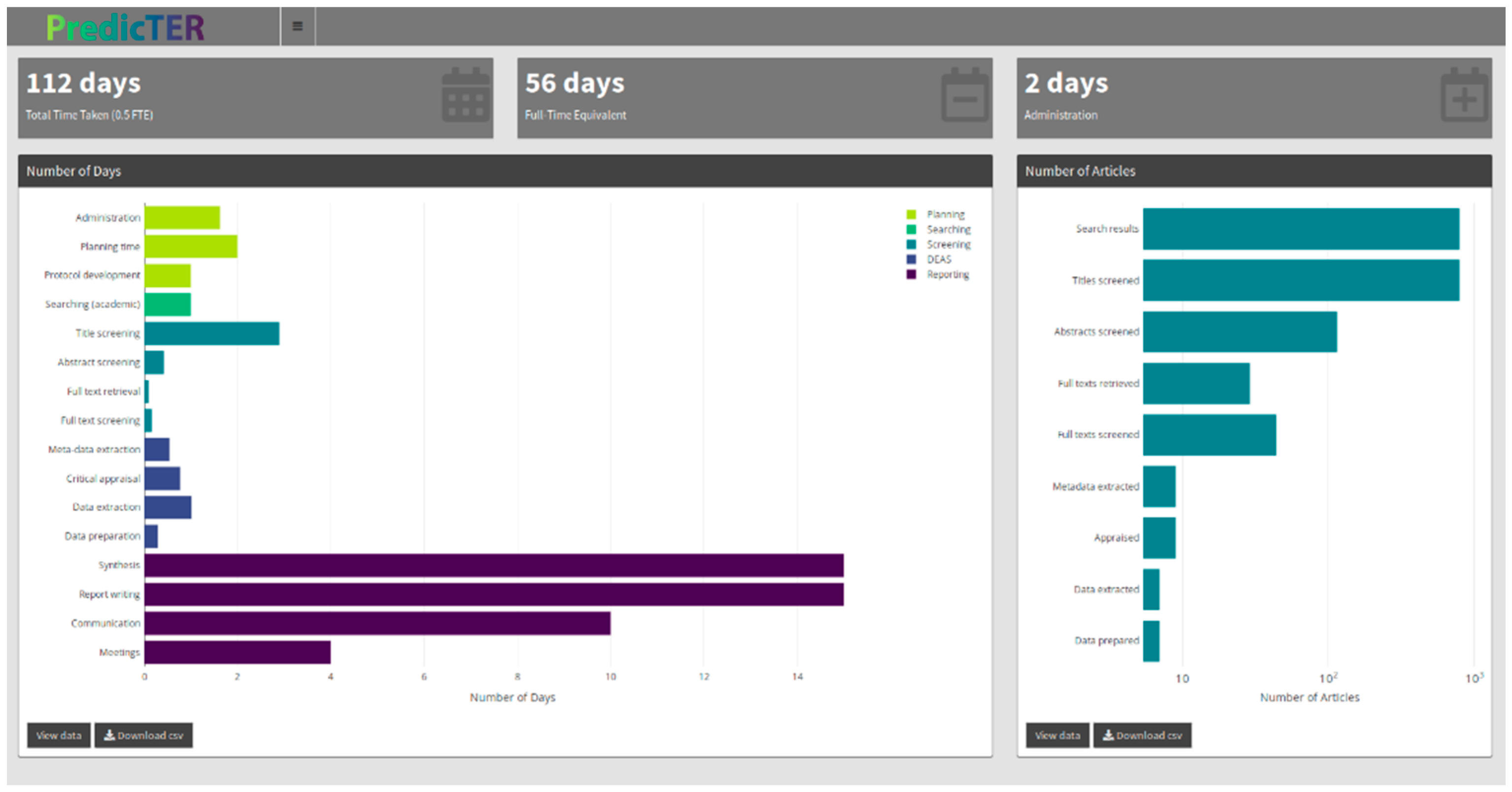
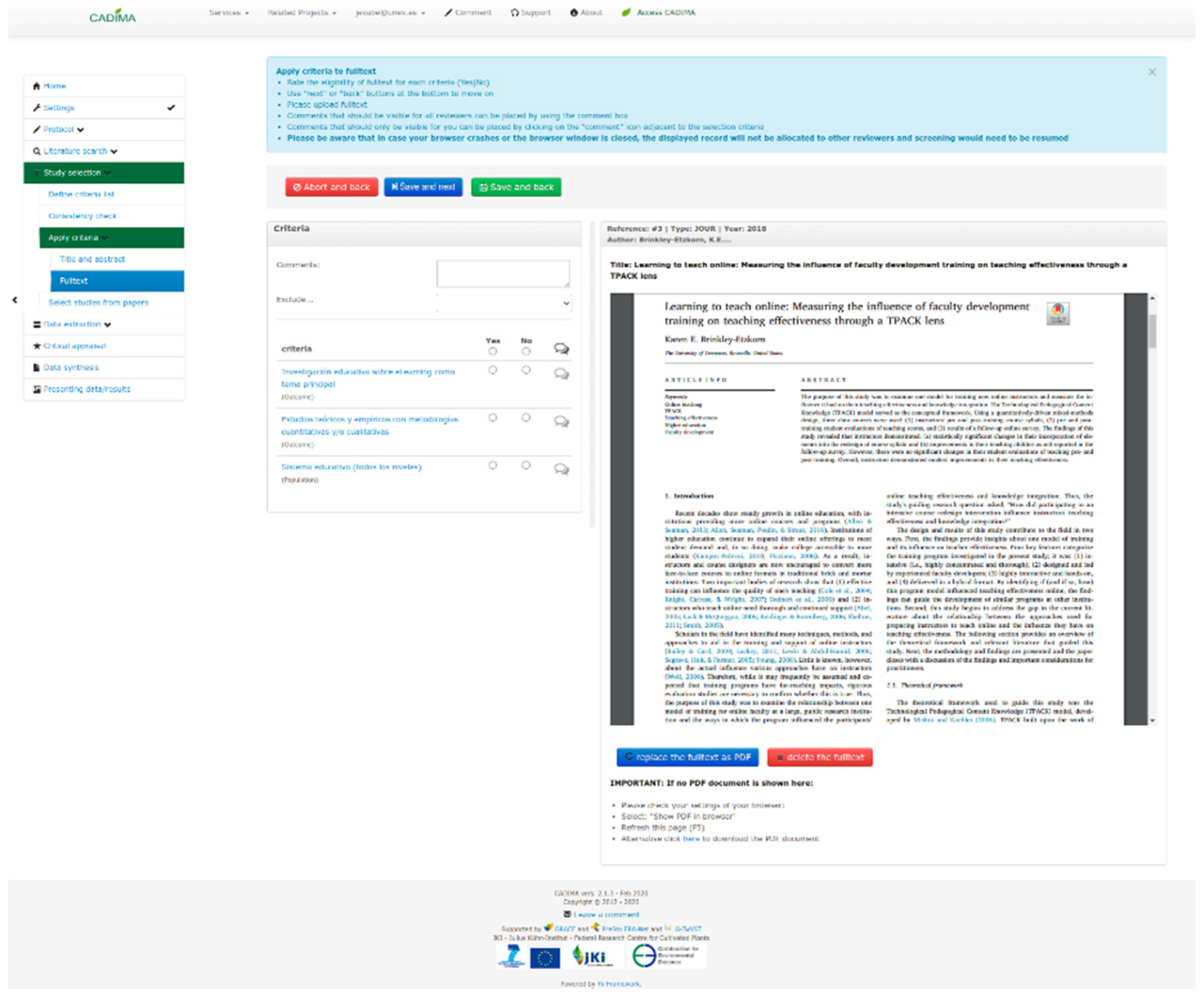
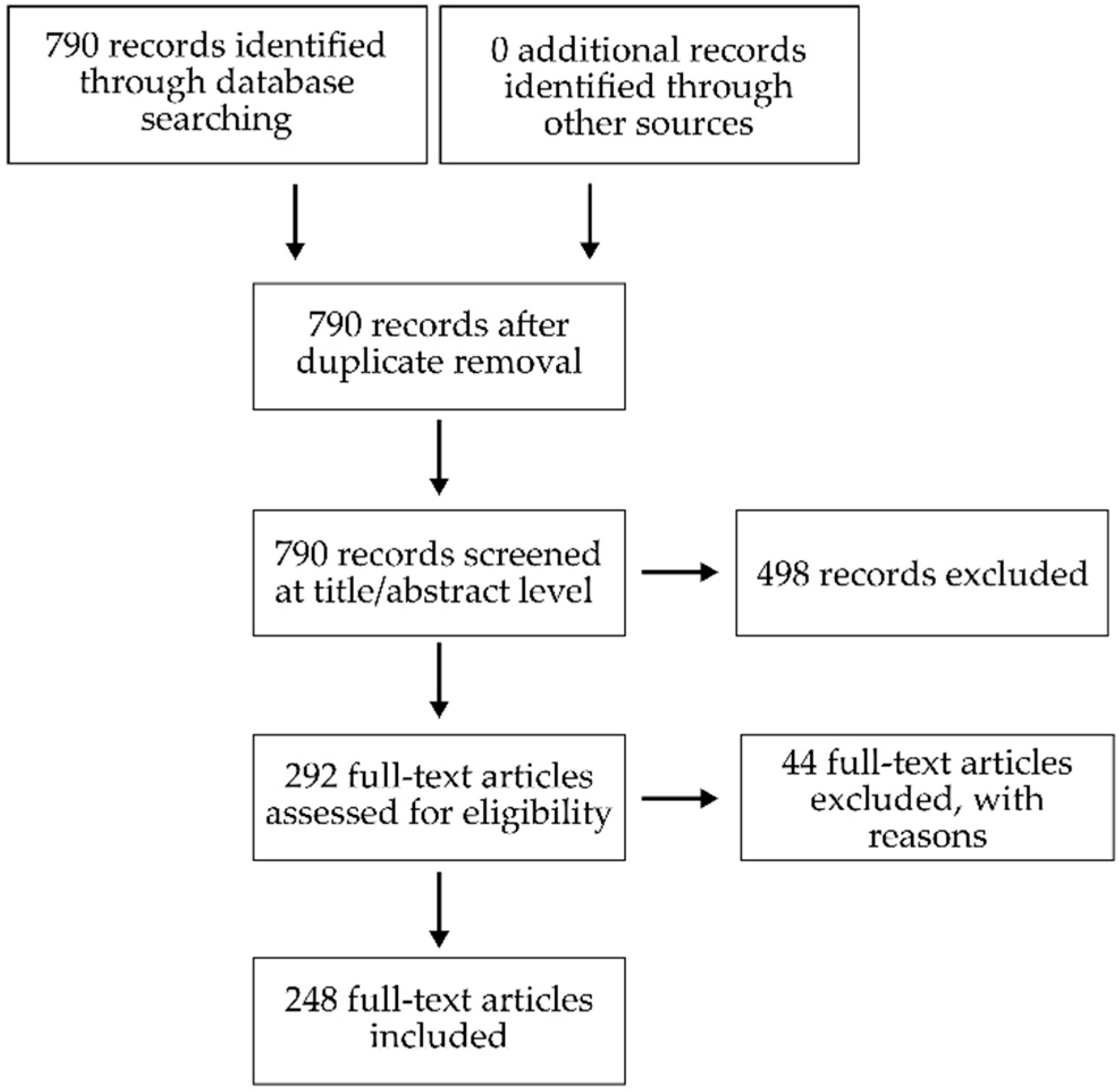

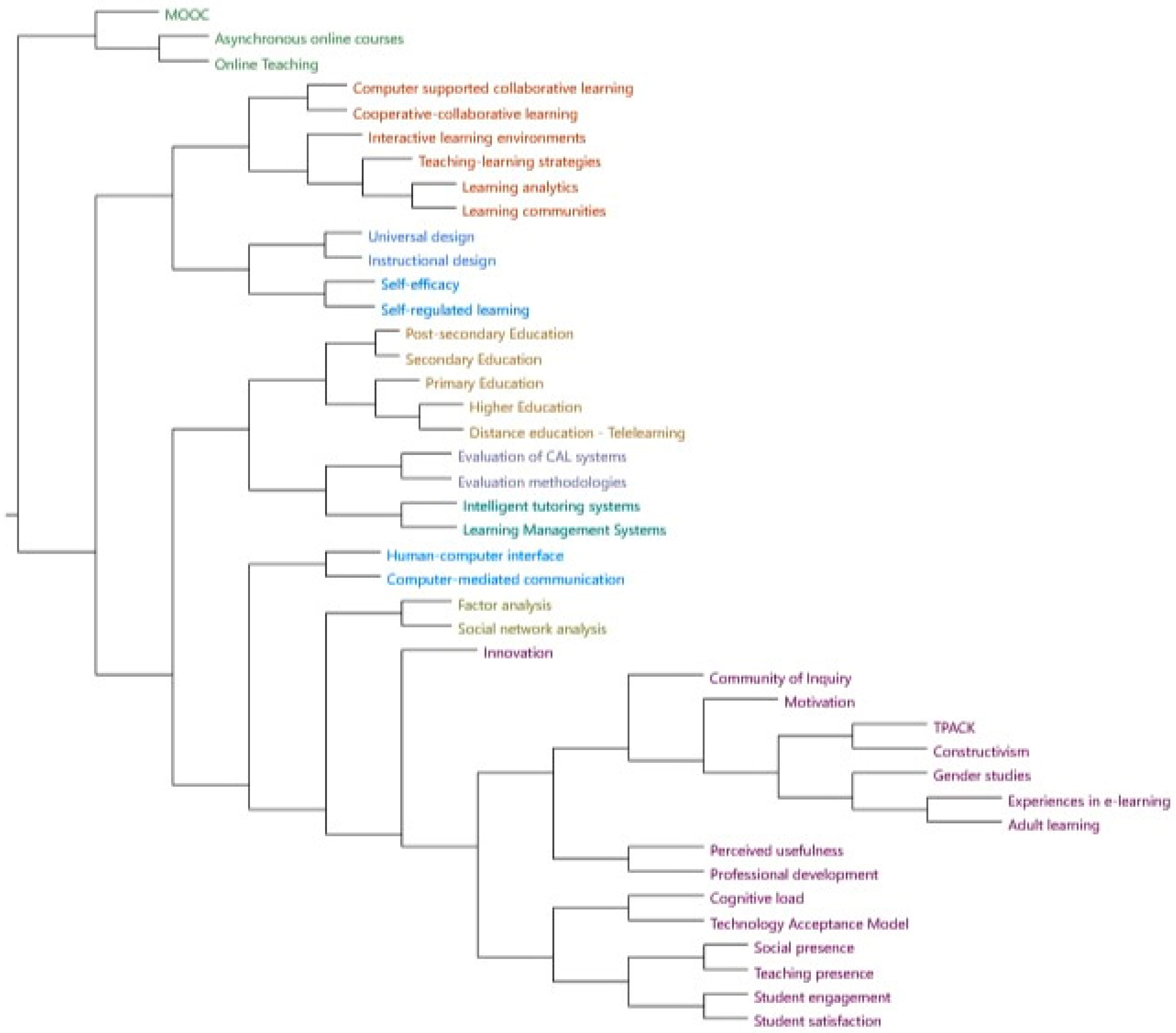
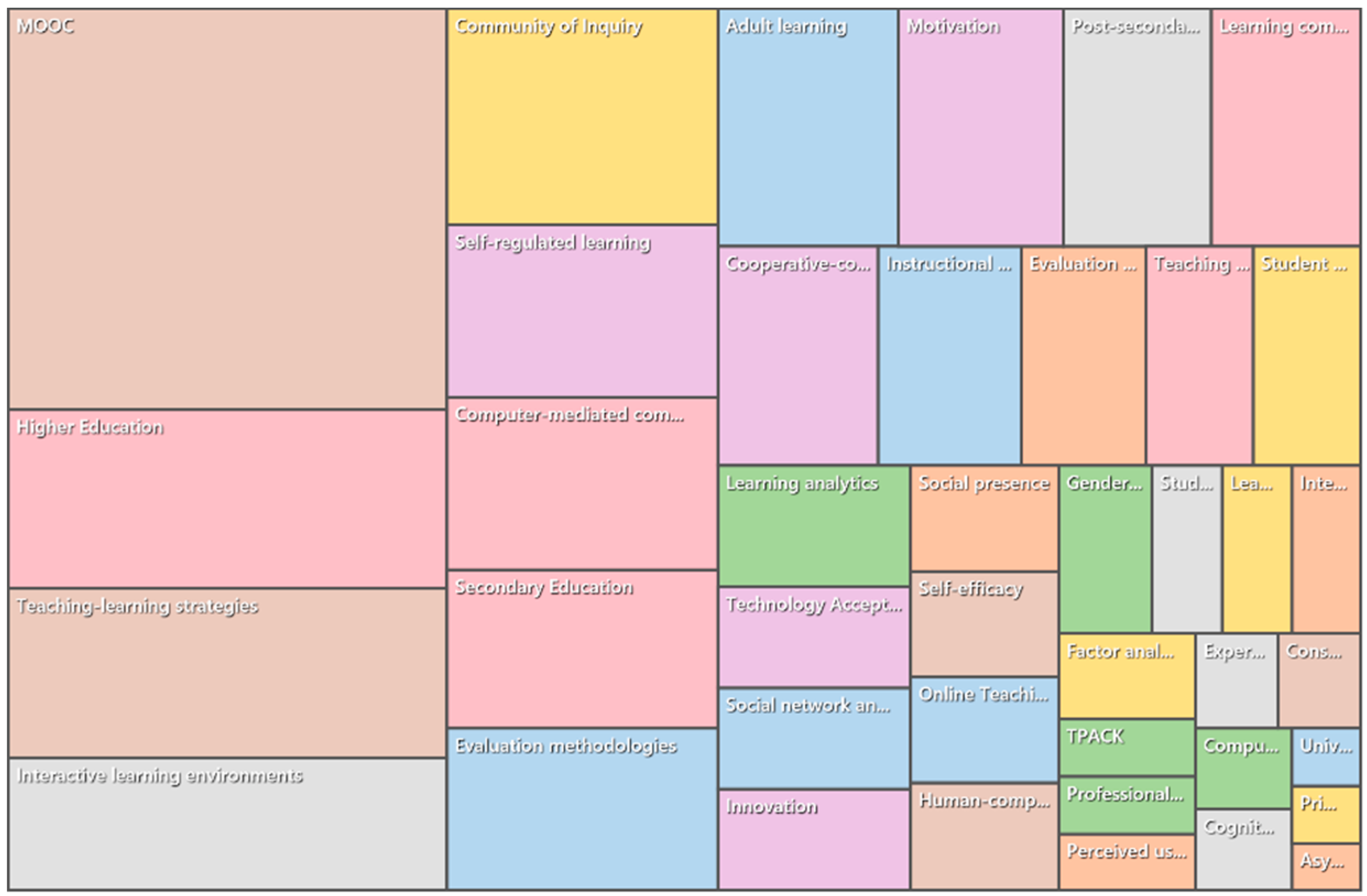
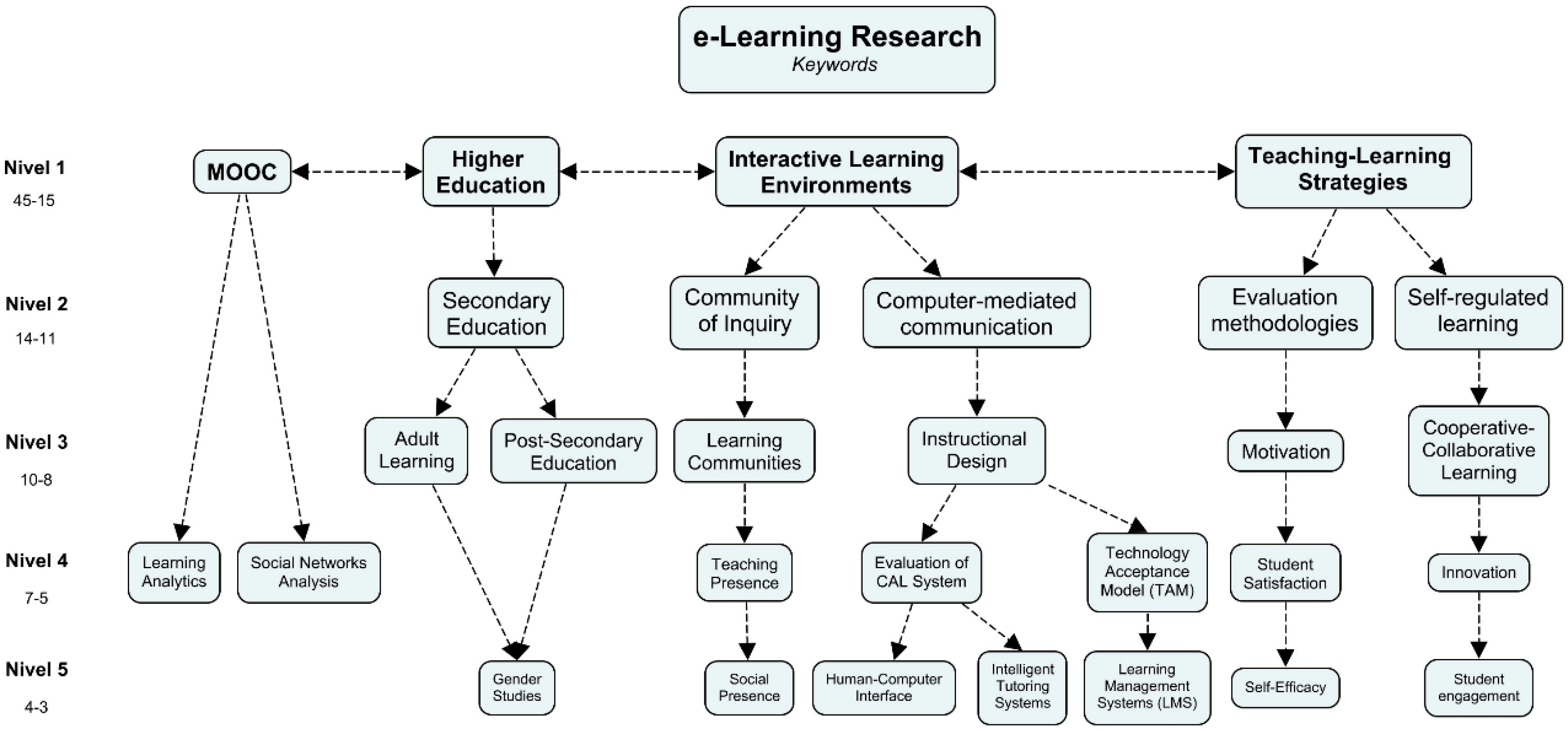
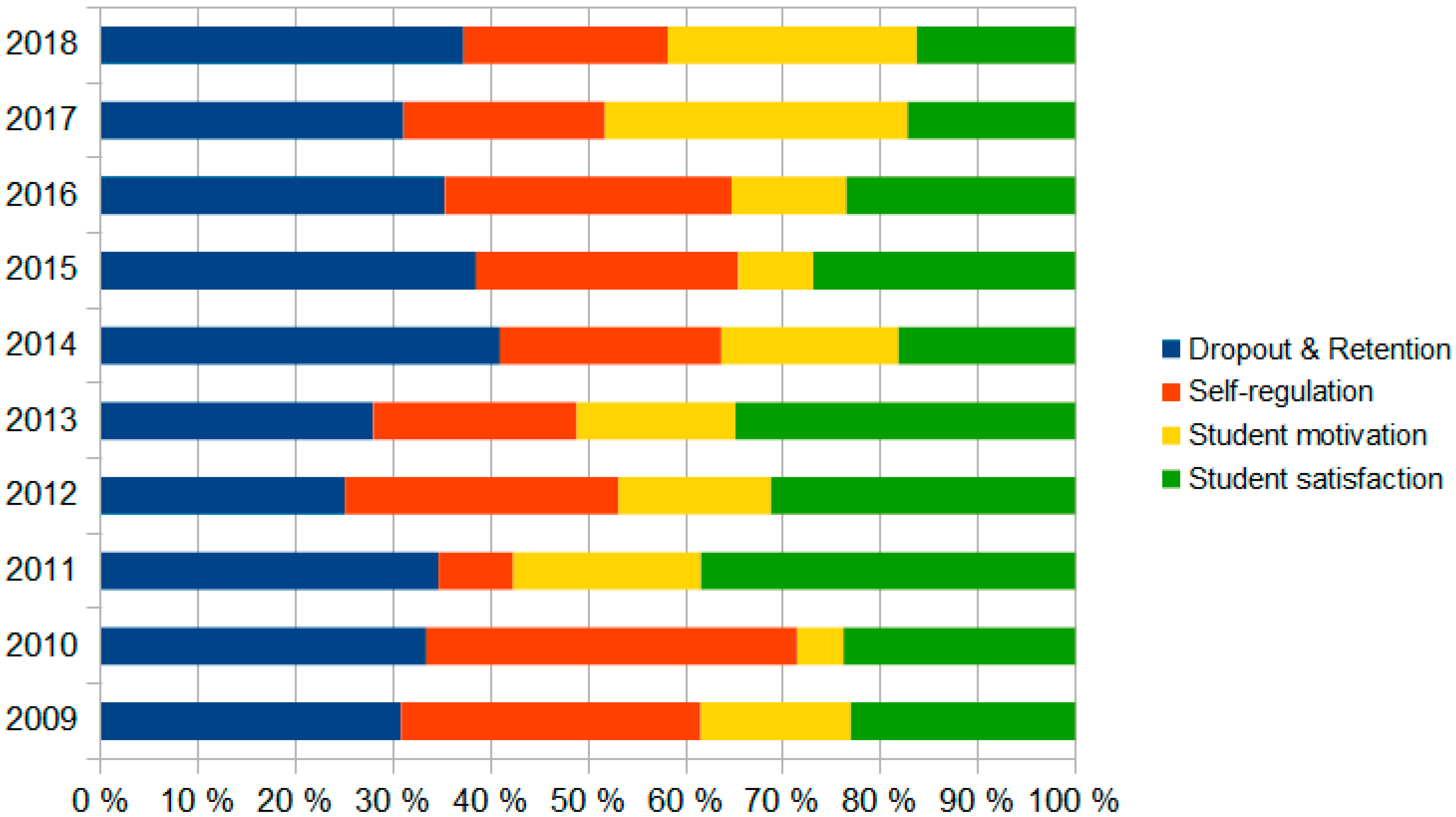
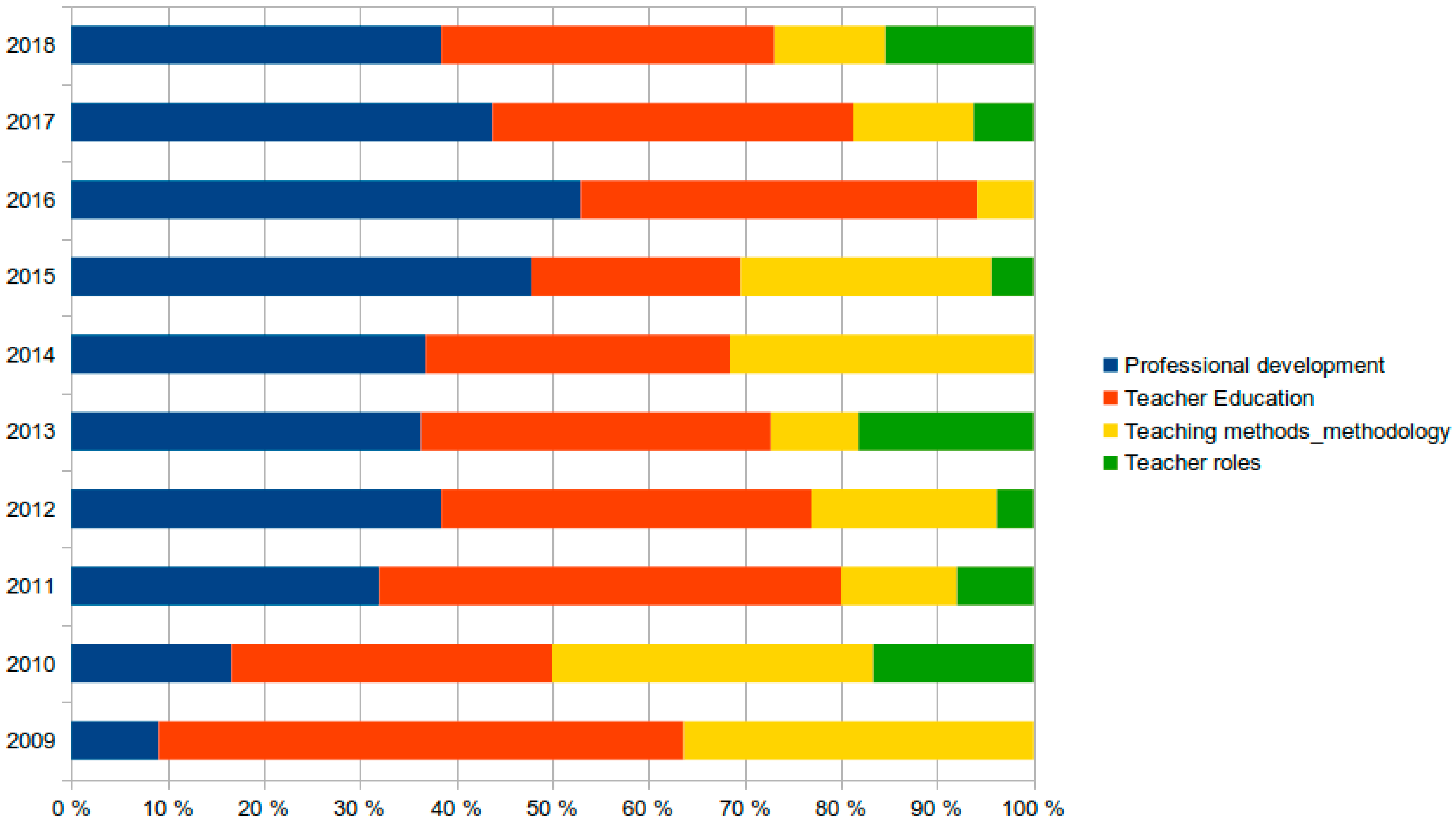
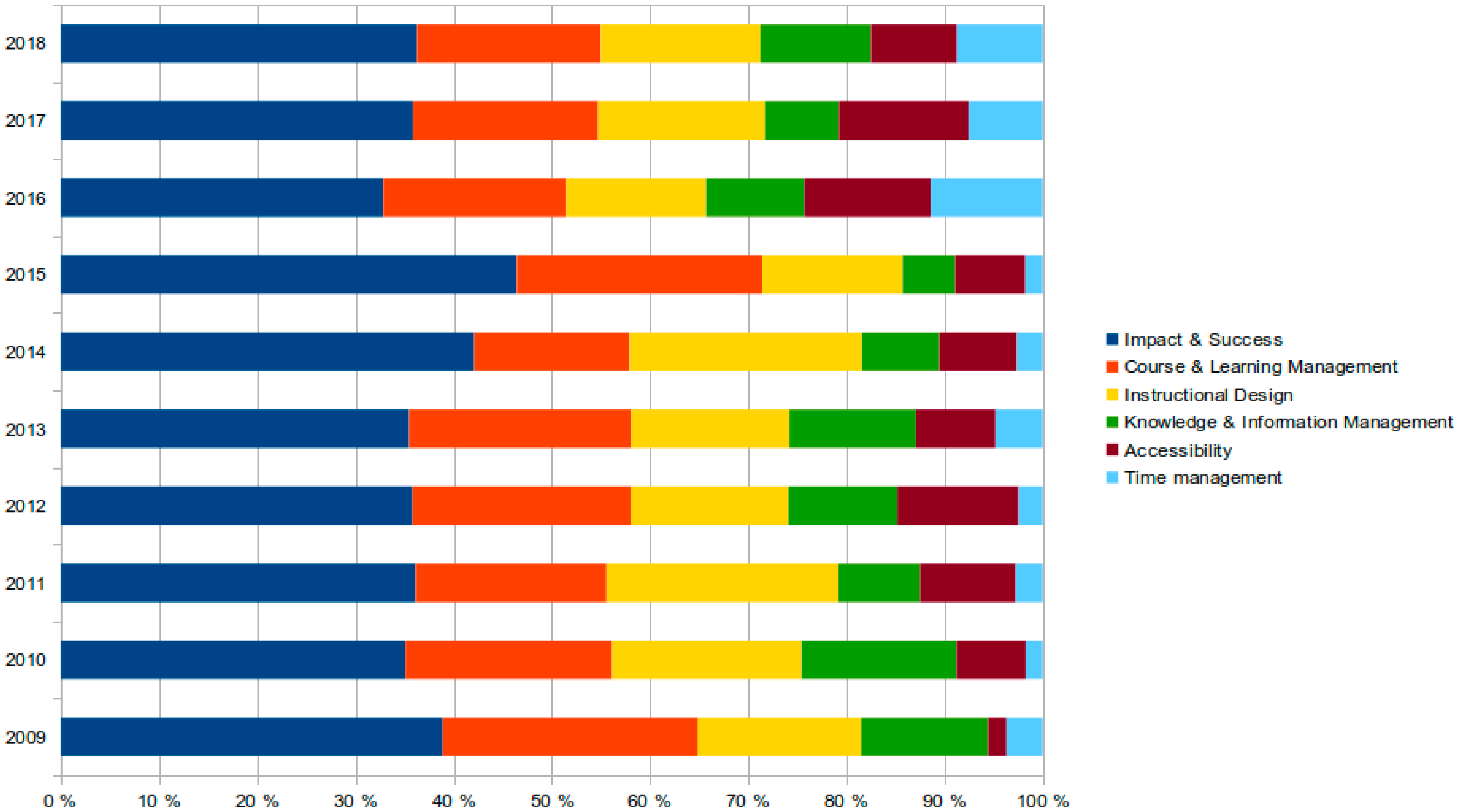
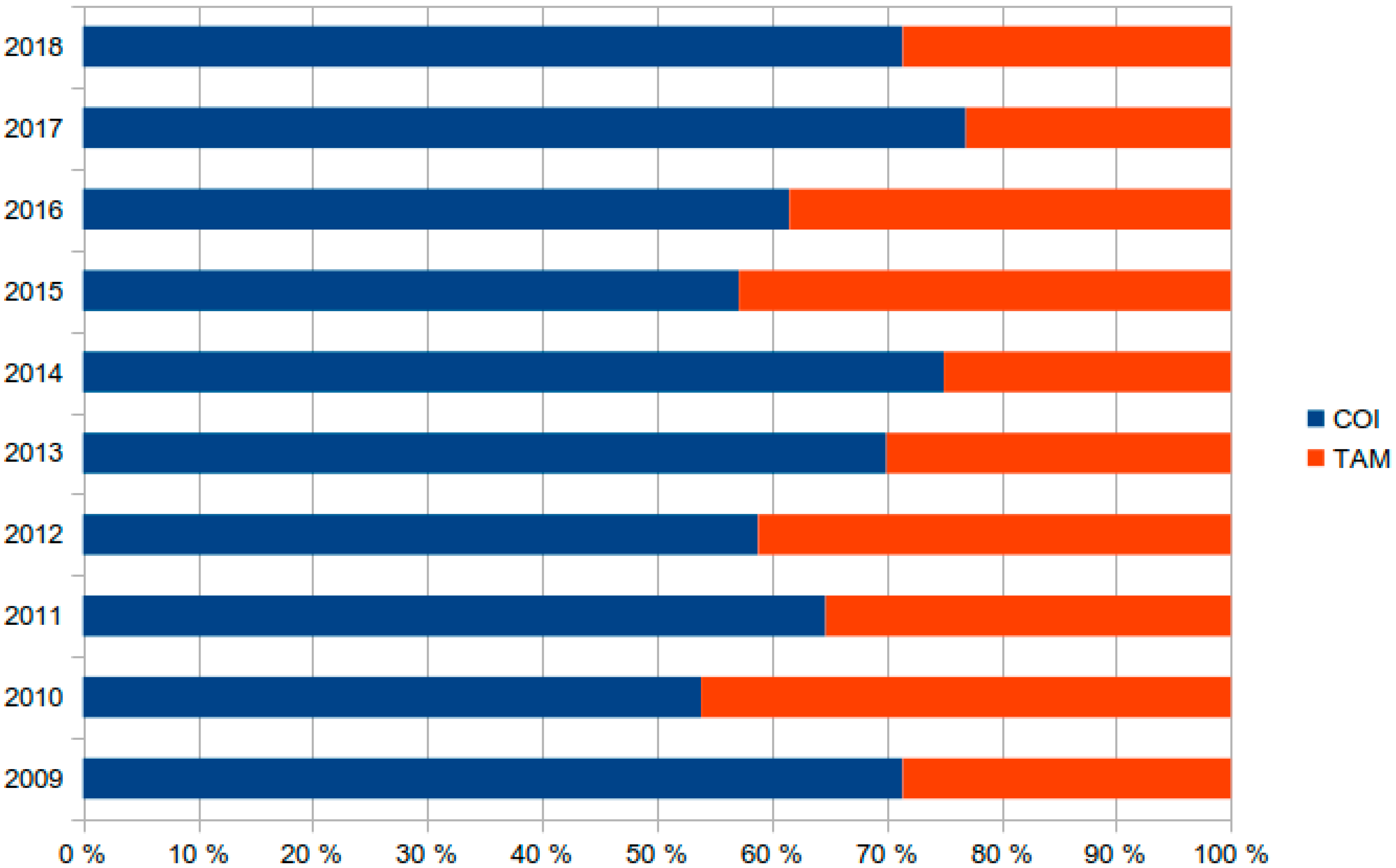
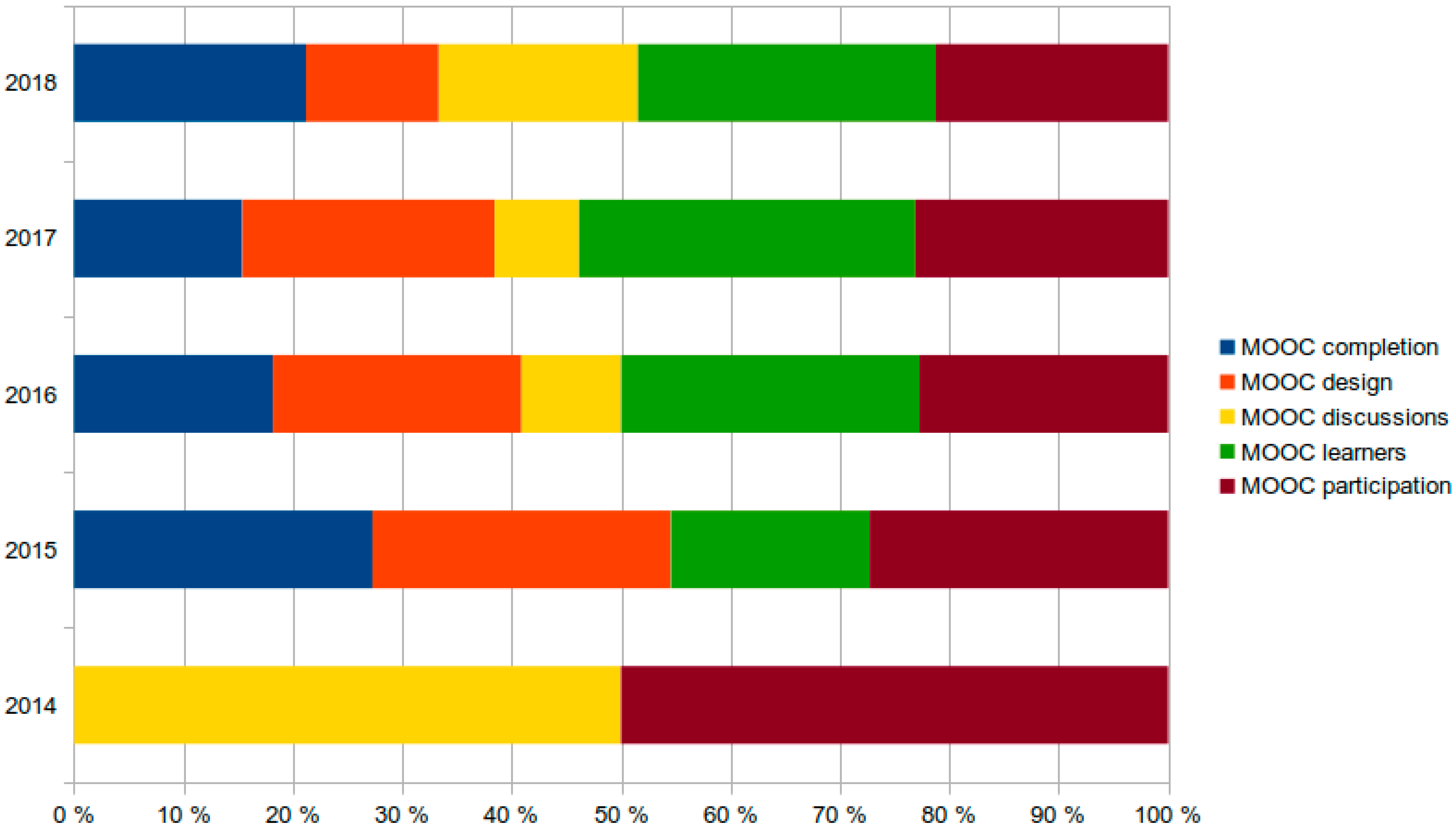
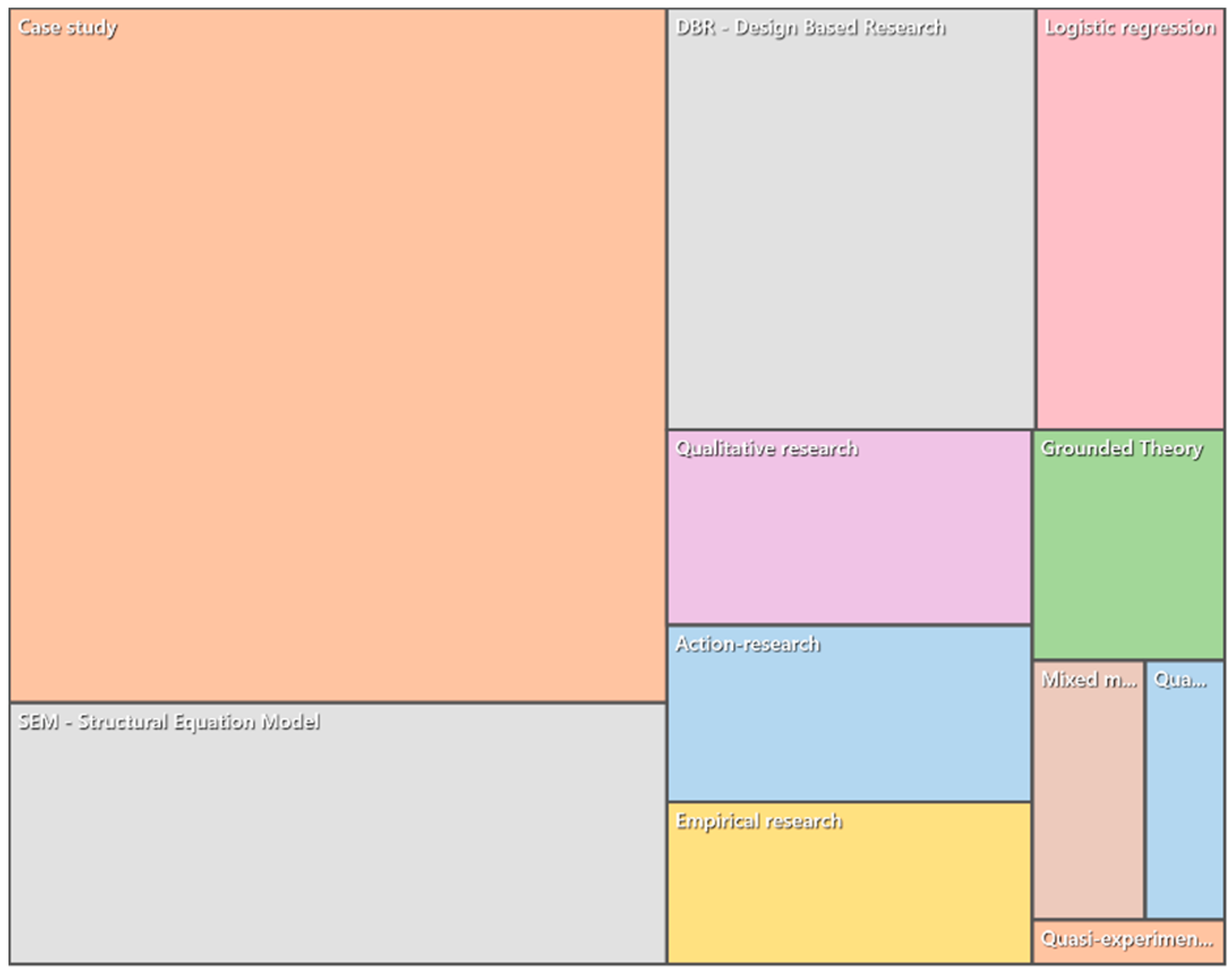
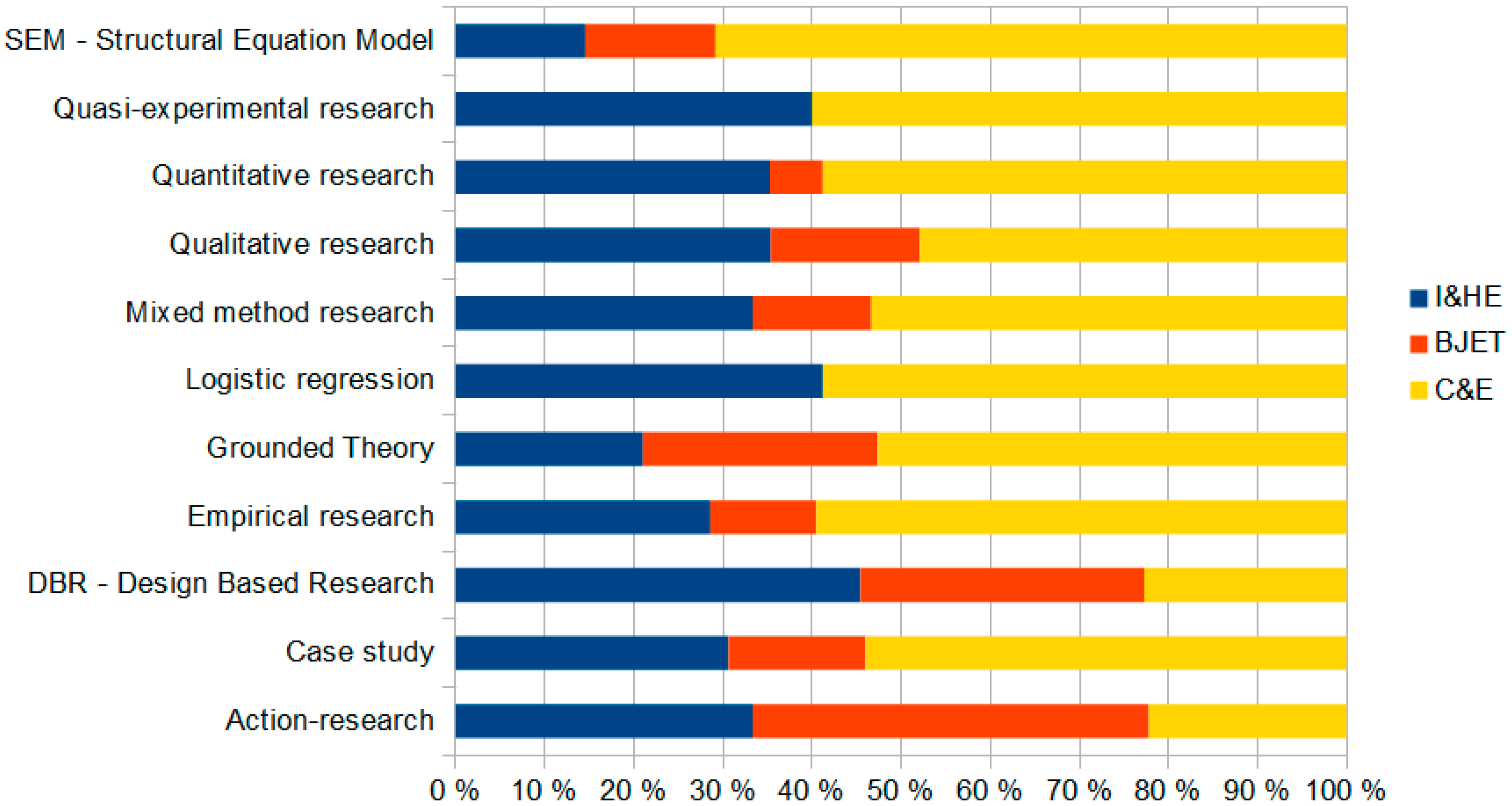
| Date | Search Term | Database | N.° of Results |
|---|---|---|---|
| 23-07-2019 | TITLE e-learning) AND TITLE (“systematic review”)) AND DOCTYPE (ar) AND PUBYEAR > 1999 | SCOPUS | 6 |
| 23-07-2019 | TITLE: (e-learning) AND TITLE: (“systematic review”) Date range (inclusive): 2000-2019. Index: SSCI, ESCI. | WOS | 15 |
| 23-07-2019 | (TITLE (e-learning) AND TITLE (“trends”)) AND DOCTYPE (ar) AND PUBYEAR > 1999 | SCOPUS | 22 |
| 23-07-2019 | TITLE: (e-learning) AND TITLE: (“trends”) Date range (inclusive): 2000–2019. Index: SSCI, ESCI. | WOS | 11 |
| Search Terms | Database |
|---|---|
| ISSN (10,967,516) AND KEY (e-learning)) AND DOCTYPE (ar) AND PUBYEAR > 2008 ND PUBYEAR < 2019 | SCOPUS |
| ISSN (0360-1315) AND KEY (e-learning)) AND DOCTYPE (ar) AND PUBYEAR > 2008 AND PUBYEAR < 2019 | SCOPUS |
| ISSN (0007-1013) AND KEY (e-learning)) AND DOCTYPE (ar) AND PUBYEAR > 2008 AND PUBYEAR < 2019 | SCOPUS |
© 2020 by the authors. Licensee MDPI, Basel, Switzerland. This article is an open access article distributed under the terms and conditions of the Creative Commons Attribution (CC BY) license (http://creativecommons.org/licenses/by/4.0/).
Share and Cite
Valverde-Berrocoso, J.; Garrido-Arroyo, M.d.C.; Burgos-Videla, C.; Morales-Cevallos, M.B. Trends in Educational Research about e-Learning: A Systematic Literature Review (2009–2018). Sustainability 2020, 12, 5153. https://doi.org/10.3390/su12125153
Valverde-Berrocoso J, Garrido-Arroyo MdC, Burgos-Videla C, Morales-Cevallos MB. Trends in Educational Research about e-Learning: A Systematic Literature Review (2009–2018). Sustainability. 2020; 12(12):5153. https://doi.org/10.3390/su12125153
Chicago/Turabian StyleValverde-Berrocoso, Jesús, María del Carmen Garrido-Arroyo, Carmen Burgos-Videla, and María Belén Morales-Cevallos. 2020. "Trends in Educational Research about e-Learning: A Systematic Literature Review (2009–2018)" Sustainability 12, no. 12: 5153. https://doi.org/10.3390/su12125153
APA StyleValverde-Berrocoso, J., Garrido-Arroyo, M. d. C., Burgos-Videla, C., & Morales-Cevallos, M. B. (2020). Trends in Educational Research about e-Learning: A Systematic Literature Review (2009–2018). Sustainability, 12(12), 5153. https://doi.org/10.3390/su12125153






